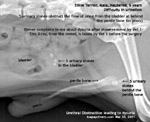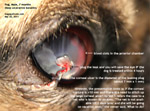A puzzling case of the male neutered Silkie, 6 years
old who can't pee normally after urinary stone removal by an
experienced vet. Around 11 days after surgery, the owner consulted
me.
OWNER COMPLAINS ON DAY 11 AFTER SURGERY BY VET 1 THAT THE DOG HAD
DIFFICULTY URINATING URINATE WHEN HE DRANK WATER. THIS HAPPENED >12
TIMES/DAY. WHY?
HE IS SUPPOSED TO BE ABLE TO PEE NORMALLY AFTER REMOVAL OF THE
URINARY STONES BY VET 1. WHAT SHOULD I DO?
I palpated the bladder. It was empty. Therefore, there was no
urethral obstruction in the sense of blockage of urine flow by the
stones at behind the os penis (see X-ray of original condition
before operation by Vet 1. Vet 1 had given the X-ray to the owner
and I asked her to e-mail to me and this was done on Mar 27, 2011
for me to review.
I told the owner that there was no problem. If a vet wants to prove
that there was no obstruction by catheterising the bladder in the
presence of the owner, that does not prove anything as palpation had
already revealed an emptied bladder and therefore no urethral
obstruction.
Bladder palpation would have told the vet that there was no
obstruction at that point of time. The dog did not have urethral
obstruction generally. So what was the cause of this puzzling
behaviour? Cystitis is a possibility. UTI possible. A small stone
from the bladder obstructing the urethra? Possible as the X-ray
would not take the kidney area traditionally.
(Tip: For good practice in veterinary medicine, it is best to keep
an X-ray record if the vet wants to give away the X-ray or record
that the owner has it).
As the owner is living far away from Toa Payoh and not to incur more
veterinary costs for her, I advised observation on the initial
complaint around 12 days post-stone removal by Vet 1. I had the
nylon-like stitches in front of the prepuce removed at the same time
and gave an anti-inflammatory and antibiotics. Then I prescribed
antibiotics, SD diet x12 and asked for urine sample. X-ray of the
bladder will be an option if necessary.
Some confusion from the owner's description of the dog's behaviour.
Was the dog having difficulty peeing or starting to urine-mark when
he was about to drink or he had some bladder infection or urinary
stone stuck behind the os penis?
All stones had been taken out by Vet 1 in my opinion as I did not
observe the surgery. It is possible that there is urethral
obstruction from a stone or two from the bladder. However, economics
deter more X-rays and tests for the time being and I did
conservative treatment to "dissolve" the remaining stones (probably
very small if present and from the kidneys) using S/D diet and
monitoring of the urine.
Instead of another X-ray which would cause the owner stress and
money, the owner was asked to monitor the dog's peeing behaviour and
given S/D diet to dissolve the remaining stones. Vet 1 had not got
the results of the crystals of the stones removed. The owner's
e-mail report is as follows:
|
E-MAIL TO DR SING DATED
MAR 29, 2011 22 DAYS AFTER SURGERY TO REMOVE URINARY STONES BY VET 1 Dear Dr Sing, Updates of my dog condition after urinal stones removal operation since 7 march 2011. Duration monitored: 30-45mins Dog Behavior: 1) his attempts to urine has cut down from 12times to 4-5times 2) 1 successful attempts out of the 4-5 tries* 3) other attempts, urine amount is less than 3ml or no urine at all. Other Conditions: - Dog is eating normally - Dog is starting to drink more; like his usual amount of intake before operation. - Dog is playing and active as usual - Currently on Dr Sing prescribe diet started 20/03/2011 - Previous Diet: brown rice with white rice, carrots, peas, tofu, a bit of garlic, salt and olive oil. He is also on an eye drop, because he has ulcer in his right eye. It is improving, not as red as before. I have not brought his urine sample down, because his condition is improving. Thus, i would like to monitor for a few more days. Dr Sing, I truly appreciate your help in giving me advise on my dog's condition. I had brought my 1st pet, a cat, to you since 1990. You are a good vet, please do not lose hope even when you have encounter more demanding pet's owners. |
MARCH 29, 2011
I phoned the owner as e-mail writing can be misleading compared to
personal conversation. She complains about a hard lump at the
stitched area. Vet 1 had stitched with the absorbable nylon-like
stitches in the muscle and the skin area after stone removal.
I had already got the skin stitches removed during the first
complaint around 12 days of what I considered a successful surgery
by Vet 1. This opinion is subject to an X-ray post-op but I did not
consider the X-ray necessary at that point of time as it is likely
to show no urethral obstruction based on my bladder palpation. The
bladder was empty and so it would be morally unethical to advise
another X-ray immediately. In any case, the original stones were
removed as Vet 1 is an experienced vet and therefore I recommended
conservative treatment.
Vet 1 should have got a urine sample for urinary stone crystal
analysis to the Singapore laboratory pre-surgery in hind-sight. Vet
1 had sent the stones to the US lab for analysis. This would take
some time but now ... I have a problem! And the owner had got her
X-ray at home. So, I asked her to e-mail to me the X-ray which my
Adobe Photoshop refused to download. I cropped and converted the
X-ray to .tiff. This time Adobe Photoshop obliged and therefore I
had the X-ray image cleaned up and presented in this report.
CONCLUSION
Post-operation complications do happen after surgeries for all vets.
The owner must be informed before surgery but sometimes we are too
busy to go into details of the risk of pain, infection and bleeding
of surgery. Many times I don't inform the owner too as the consent
form for surgery would have been signed by the owner. During my past
20 years, I seldom ask the owner to sign the consent form (for
informed consent) but now I better be careful of possible litigation
for "failure to provide informed consent."
It is hard to pin-point the cause of the dysuria in this dog.
Certainly it is not the typical urethral obstruction at the os
penis, in my experience and observation.
Dogs can't talk. That's the challenge of being a
veterinarian. It takes a lot of time and patience to know what is
going on in this case. From the owner's phone conversation and
observation, I conclude that this dog might have some pain due to
the muscle stitching and so he tried not to pee during the first 14
days post-op. As I know Vet 1 used those absorbable "nylon-like"
stitches to suture, I infer that the stitches were irritating the
dog at that critical area in front and below the prepuce. I had
removed the skin sutures but below, there was another layer of
muscle suture at the linea alba. This would be the area of pain
which lessened with time and medication. So the dog now has much
lesser frequency of urination pain and has improved considerably
according to the owner's diligent monitoring of urination.
|
In conclusion, one main
cause of the post-surgical dysuria is the pain at the
stitched abdominal muscle area below the penis (to close
up the operation after urinary stone removal). My tip to vets will be to use the 3/0 absorbable non-nylon like sutures. There is no need to stitch the muscles at 0.5 mm apart resulting in many stitches. I stitch at 1 cm intervals. Also, I find that subcuticular stitches are not necessary but many vets do that. This means a lot of stitches (subcuticular and muscle) and this would result in stitch irritation especially when the vet uses the "nylon-like" absorbable stitches. This is probably what is happening to the dog in this case. Every time he pees, the heavily stitched muscle and subcuticular area causes pain. So when he wants to drink water, he tries to pee first but feels the pain. At other times, he pees onto the pee tray with difficulty. The owner disputed my opinion of the male dog urine-marking as the dog has no such habit. *So as at March 30, 2011 as I close this case, I have only this hypothesis of pain due to stitches, not urethral obstruction by urinary stones behind the os penis. 22 days after surgery, the dog has fewer episodes of dysuria (see owner's e-mails above) . If only dogs can talk! And if only we vets have more time to analyse the cases but we don't have the luxury of time! And Singaporean pet owners want instant answers! |
I don't have any complaint in my urinary stone
removal surgeries using such the 3/0 non-nylon suture type for
closure of the bladder, abdominal muscle and skin . It dissolves
usually in 28 days and that is more than sufficient time for healing
of the operated wounds. I don't use subcuticular sutures as I found
them unnecessary in these cases. The University professors in
Australia (from my observation of some graduates' need to do
subcuticular suturing) still teach the students the need to
eliminate dead space under the skin and therefore subcuticular
sutures are used by many fresh graduates.
"Nylon" type absorbable sutures will take a much longer time to
dissolve. The owner can "feel" the "lump" for some time. In
veterinary practice, perception is sometimes as important as
competence. Why use nylon-like stitches to create "lumps" under the
skin worrying the dog owner and risking loss of owner's confidence
in the vet when good alternatives are available? As each vet has his
own preference, it will be hard to convince such vets to switch
suture types!
I may be fortunate in my cases of no complaints of post-operation
dysuria. Or the owner might have gone to another vet for a second
opinion as in this case!
 TOA
PAYOH VETS
TOA
PAYOH VETS

